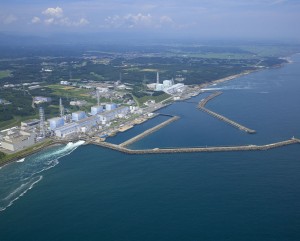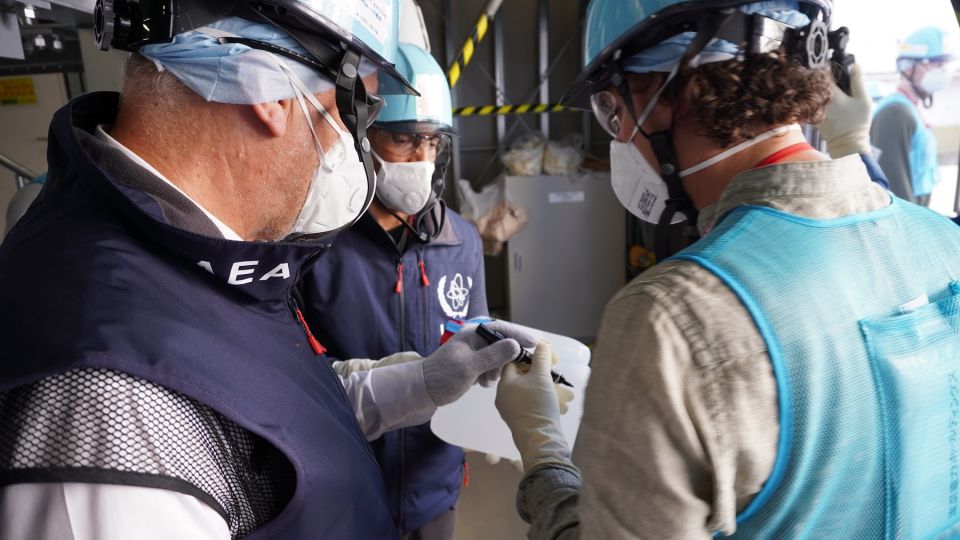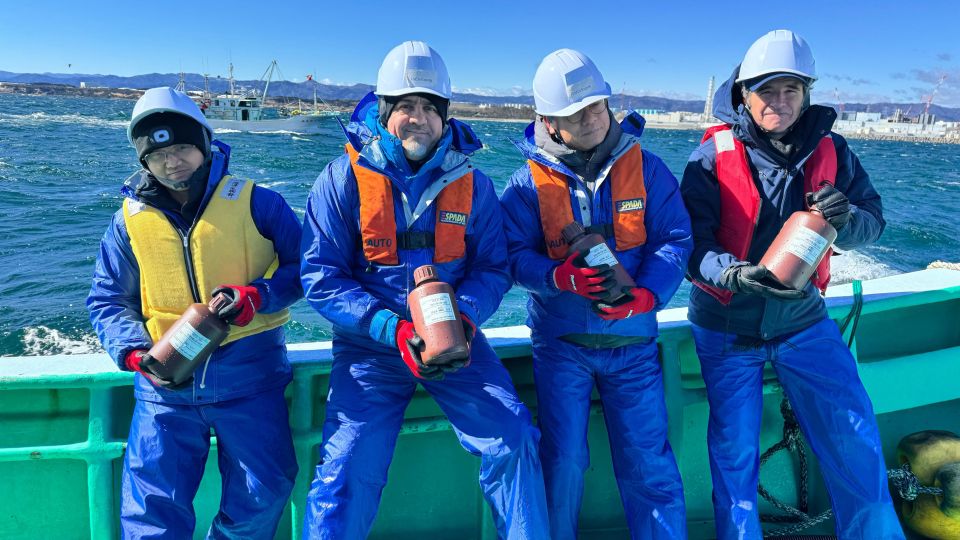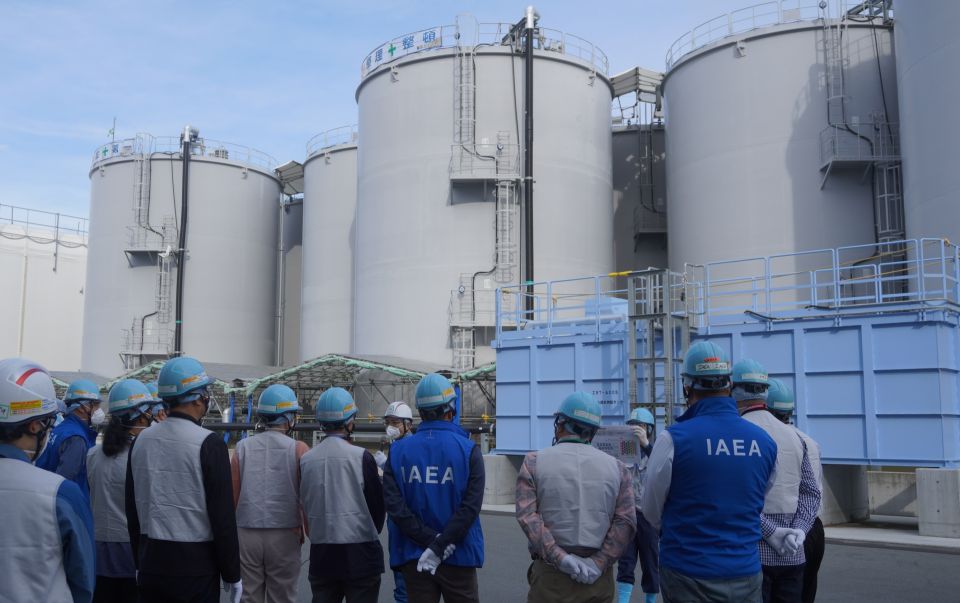Radiation Levels Not "Soaring" At Fukushima Daiichi
A number of media sources reported last week, and continue to report this week, that "radiation levels are soaring" at the Fukushima Daiichi nuclear power plant in Japan and that radiation levels have reached levels that unnamed "experts" are finding "unimaginable." All of these claims are demonstrably false.
Let's take a look at what's been going on at the Fukushima Daiichi plant as far as the reports that have been made by plant owner Tokyo Electric Power Co. (TEPCO), how those reports compare to expectations of experts, and what we can make of the reports. Also, we'll look at the "reporting" that is in the news and is trending on social media platforms.
When the accident occurred at the site, the nuclear fuel, which melted inside the reactor pressure vessels in each of the three operating units, caused damage to those vessels. In such an event, the molten fuel combines with other structural non-fuel materials in the reactor internals and forms a molten slag we call corium. The composition of corium differs for any and every different kind of reactor and the degree of damage. This corium, however, if not cooled, is capable of damaging the inches-thick steel reactor vessel. If that happens, then corium could leak out of the vessel and, in this particular design of reactor building used at Fukushima Daiichi, could fall into the pedestal area that holds up the reactor vessel. This pedestal area, however, is inside of a very large primary containment or containment vessel, the job of which is to contain any kind of accident that may occur to the reactor.
Some illustrations will be helpful to explain what occurred in the accident and what's happening now. During the accident, the reactors at Units 1, 2, and 3 of the Fukushima Daiichi generating station were damaged. (See photo, which enlarges when clicked.)
Two groups of nuclear units can be seen at this plant. Units 1 through 4 are seen the photo in line at the left, and set a bit further to the north are Units 5 and 6. The tall and square-shaped structures are the six reactor buildings. On the sea side of these buildings are the units' turbine buildings, all built end-to-end with each other. Of the four units that are grouped together, Unit 1 is the furthest north and has a slightly smaller reactor building than Units 2, 3, and 4.
Only Units 1, 2, and 3 were actually operating when the tsunami hit that led to the Station Blackout event that caused the nuclear accident. Let's take a closer look at what's inside each of the tall reactor buildings.
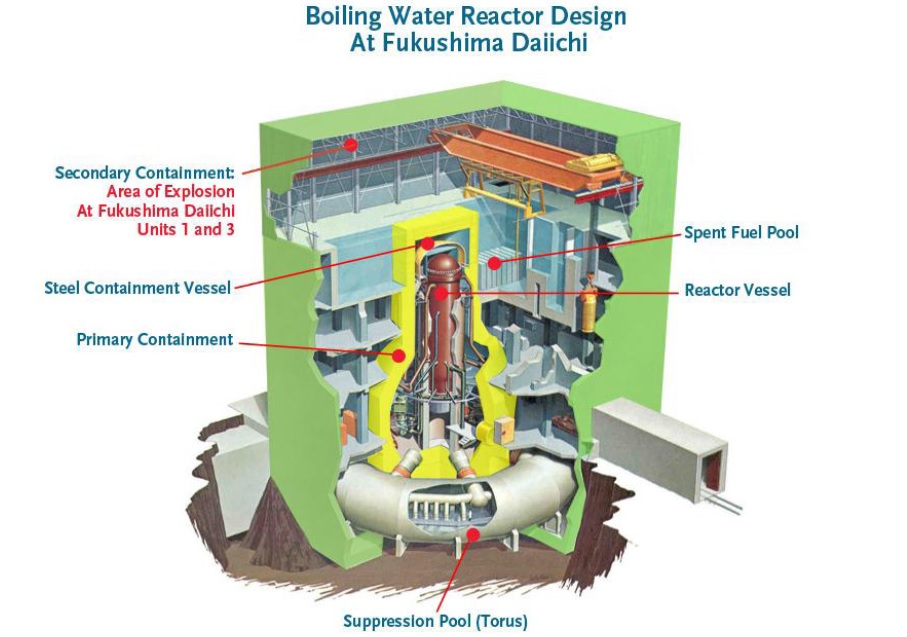
BWR/5 reactor in Mark I Pressure Suppression Containment. Illustration courtesy INPO.
In the above illustration from the (open distribution) Institute of Nuclear Power Operations report on Fukushima Daiichi, we see a typical reactor building for the generation of boiling water reactor that exists at this site. The reactor vessel and the primary containment are clearly labeled. The nuclear fuel itself is inside the reactor vessel, along with the structures required to align and support it. The control rods that are used to control or halt the fission reaction are also inside the vessel.
Below is a much simpler cross section of a reactor building from TEPCO. It shows the location of the components and the damaged fuel, some of which is still inside the reactor vessel and some of which has fallen below into the pedestal. This situation exists at Units 1, 2, and 3 at Fukushima Daiichi to varying degrees.
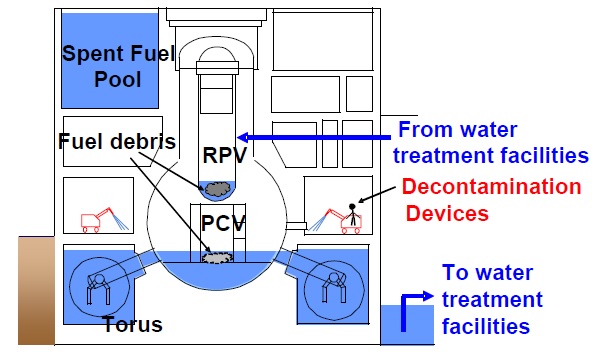 Since the accident, TEPCO has been keenly interested in determining the exact state of the melted fuel and the reactor pressure vessels in each of the three damaged units. This determination is a key issue for the cleanup of the site. As a result, TEPCO has been poking instruments and robots into the containment vessels closer and closer to the area of the damaged fuel, as well as conducting muon tomography of the reactor buildings to try to see whether there is still fuel inside the vessels. (Muon tomography can be described as a giant x-ray of the buildings using muon particles instead of x-rays and using complicated muon detection equipment.)
Since the accident, TEPCO has been keenly interested in determining the exact state of the melted fuel and the reactor pressure vessels in each of the three damaged units. This determination is a key issue for the cleanup of the site. As a result, TEPCO has been poking instruments and robots into the containment vessels closer and closer to the area of the damaged fuel, as well as conducting muon tomography of the reactor buildings to try to see whether there is still fuel inside the vessels. (Muon tomography can be described as a giant x-ray of the buildings using muon particles instead of x-rays and using complicated muon detection equipment.)
As one might expect, moving closer and closer to the damaged fuel itself is impossible for humans because of the radiation level in proximity to the fuel. This is exactly why TEPCO has been using various robots, snake cameras, and so forth to approach these areas. Recent examination at Unit 2 only has led to the crop of reports that have been causing concern in the last two weeks.
TEPCO has been quite clear about what it's been doing. The following links show the investigations during the push to get very close to Unit 2's pedestal (under the reactor vessel) and perhaps damaged fuel, and are linked here in chronological order.
- X-6 Penetration, Unit 2 (January 26)
- Inside Pedestal, Unit 2 (January 30)
- Pre-Investigation Results Inside Unit 2 Pedestal (January 30)
- Pre-Investigation Results (Analysis of Digital Images) Unit 2 (February 2)
During these investigations, TEPCO officials apparently quoted to the press that a perceived radiation level of roughly 530 Sv/hr, (53,000 R/hr) was estimated in the Unit 2 pedestal area. The stated level has an error of +/- 30 percent. Further, this was not a direct measurement, but instead was based on the effects on the inserted camera and/or video signal. It is important to note that at no time has TEPCO obtained a radiation reading as close to the reactor vessel as at this time. So, while earlier readings both inside the containment vessel and within close range on the exterior of the vessel are much lower, the measurements are also not nearly taken at the same spot. This is not a "soaring" level, but actually just the first detection of the actual level at a place nearer to the damaged fuel.
No announcement of any altered radiation levels anywhere on the site, or outside of it, has been made because there are no level changes. (The site is surveyed frequently and the results permanently kept.)
As to the radiation level of 53,000 R/hr being "unimaginable," this is actually far from the case. Radiation levels in close proximity to melted fuel at Chernobyl have consistently been described as being "well over 10,000 R/hr." An actual level of 100,000 R/hr was reported near the small, aqueous homogeneous type HRE-2 reactor after it developed a hole in its reactor vessel in the late 1950s. (Fortunately, this experimental reactor was extremely small and no effects outside the area of the reactor facility were experienced.) So, a reading such as has been guessed at by TEPCO's spokesman at a location approaching the damaged reactor vessel and fuel at Fukushima Daiichi Unit 2 is not unimaginable. Instead, it is realistic. This level has nothing to do with any dose or exposure rate anywhere else, except right at that location. As stated, the actual level has not changed anywhere else on site. (Of course, since radioactive materials decay over time, the levels everywhere are going DOWN over time. The only change off site from this would be if there were any new release of material to the atmosphere or environment, which hasn't happened.)
Some outlets have reported that a hole was discovered in the reactor vessel. The plain fact is that TEPCO hasn't seen the reactor vessel yet inside any of the units. What happened is that, apparently, a section of grating, or walkway surface, below Unit 2's reactor vessel fell out. The rest of the grating appears to be covered with a lumpy material that could be anything from melted fuel to dissolved substances that resolidified, including paint. Much further investigation is required to determine why the grating is missing and what the substance on the grate is, but readers may be assured that no hole was discovered in the reactor vessel, because the cameras have not been able to look up yet.
It's very important to remember that a trending story on social media isn't necessarily accurate or even sensible. In this case, selective outlets have pushed the hyperbole to a new level in an attempt to get clicks and page views, which of course is how they pay their bills. The actual facts are far less frightening and sensational, and may just allow everyone to return to what they were doing before without worrying any further about this "news."
- For continuous updates, the Hiroshima Syndrome blog has been consistently the most timely and accurate source for Fukushima accident information. It continues even now to be updated at least weekly. Click here to read it.
- My own personal blog, Atomic Power Review, hosts a page compiling official reports from bodies all over the world on the Fukushima Accident. Click here to read it.
- Five Years from Fukushima: Where Are We Now? March 2016 piece on developments since the accident. Click here to read it.
- ANS Nuclear Cafe's three-year anniversary piece on the Fukushima accident with a number of added informative links. Click here to read it.
 Will Davis is Communications Director and board member for the N/S Savannah Association, Inc. He is a consultant to the Global America Business Institute, a contributing author for Fuel Cycle Week, and he writes his own popular blog Atomic Power Review. Davis is also a consultant and writer for the American Nuclear Society, and serves on the ANS Communications Committee and on the Book Publishing Committee. He is a former U.S. Navy reactor operator and served on SSBN-641, USS Simon Bolivar.
Will Davis is Communications Director and board member for the N/S Savannah Association, Inc. He is a consultant to the Global America Business Institute, a contributing author for Fuel Cycle Week, and he writes his own popular blog Atomic Power Review. Davis is also a consultant and writer for the American Nuclear Society, and serves on the ANS Communications Committee and on the Book Publishing Committee. He is a former U.S. Navy reactor operator and served on SSBN-641, USS Simon Bolivar.


